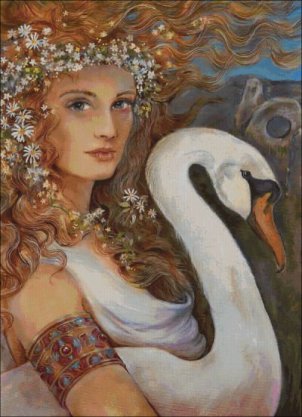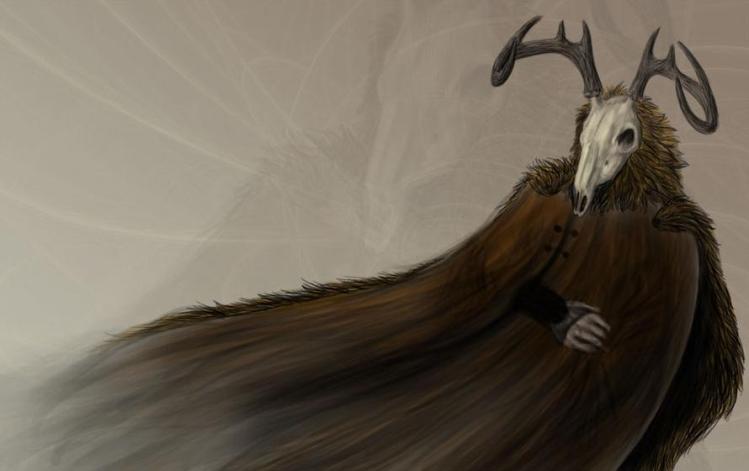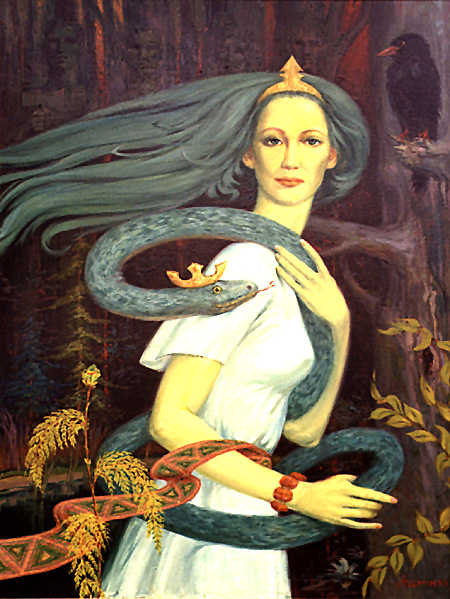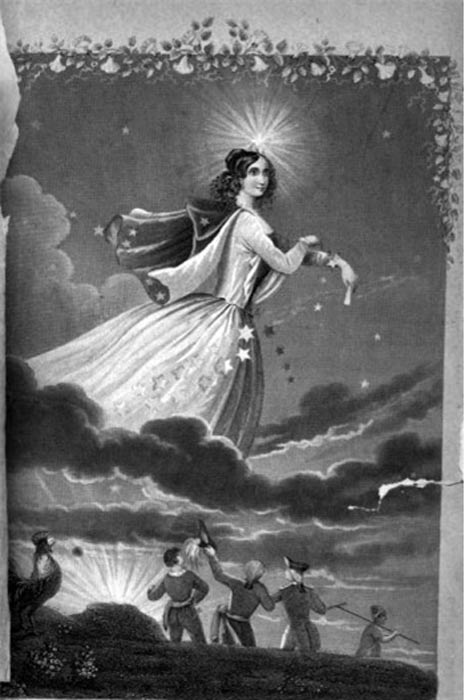Sunday 5 November 2017
Mythology: Laima
Laima is one of the many figures that appears in Baltic mythology and appeared in both Latvia's and Lithuania's pre-Christian religions. She is regarded as a goddess of fate and fortune, and is associated with the linden tree. Another of Laima's functions was as the patron of pregnant women.
In Latvian beliefs, Laima and her sisters, Karta and Dekla, were a trio of fate goddesses - a role similar to that of the Norse Norns and the Greek Moirai. In this role, Laima's functions and roles were more associated with mothers and child birth. Whereas in Lithuanian beliefs, Laima could appear as either one goddess or as a trio. She also had many functions and duties, one of the most important of these was to map out how a newborn's life would proceed.
Image source: Journeying To The Goddess.
* * * * * * * * * * * * *
Don't forget to follow me on Facebook and Twitter!
http://facebook.com/NorthSeaPoet
http://twitter.com/NorthSeaStorm
Also, my debut book A FUNERAL IN EREBUS is now out can be purchased for £7 from this location!
You can also pledge to me on Patreon: http://patreon.com/NorthSeaPoet
Friday 20 October 2017
Arawn's Hunt
Samhain’s moon rises
And the wild hunt begins
Death’s king rides forth
With blood red hounds
From Annwn they flee
Souls of the ever-damned
Arawn's Hunt is based on the stories of Arawn in Welsh mythology. The tale that I based this poem on says that Arawn, king of the Otherworld, would hunt souls down during in the time of Samhain should they ever flee from Annwn.
* * * * * * * * * * * * *
Don't forget to follow me on Facebook and Twitter!
http://facebook.com/NorthSeaPoet
http://twitter.com/NorthSeaStorm
Also, my debut book A FUNERAL IN EREBUS is now out can be purchased for £7 from this location!
You can also pledge to me on Patreon: http://patreon.com/NorthSeaPoet
Also, my debut book A FUNERAL IN EREBUS is now out can be purchased for £7 from this location!
You can also pledge to me on Patreon: http://patreon.com/NorthSeaPoet
Gowdie
Bonnie Isobel
Of Gaelic blood
By Hecate's grace
And Liltih's hand
Black arts she claimed
From woman to hare
Under night's veil
She would go
With sorrow and care
'Til home she came again
Gowdie is a piece inspired by the story of Isobel Gowdie, a Scottish woman accused of witchcraft. There is little information of her life and no record of her ever being executed.
* * * * * * * * * * * * *
Don't forget to follow me on Facebook and Twitter!
Don't forget to follow me on Facebook and Twitter!
http://facebook.com/NorthSeaPoet
http://twitter.com/NorthSeaStorm
Also, my debut book A FUNERAL IN EREBUS is now out can be purchased for £7 from this location!
You can also pledge to me on Patreon: http://patreon.com/NorthSeaPoet
Thursday 8 June 2017
Amber Tears
Across storm-ridden waves
Her sorrowed voice echoes
Where the crest meets the shore
Her ambers tear crown the strand
Evermore, her love, she mourns
Amber Tears is taken from my upcoming book, She Set The Sky Ablaze, and is loosely based on the story of Jurate and Kastytis. There are various versions of the story but the basics remain intact.
The tale goes that the Goddess (sometimes a mermaid) Jurate lived in an amber castle within the Baltic Sea and ruled over all the sea life, as well as the sea itself. A young fisherman, Kastytis, disturbs the peace by catching all the fish. Jurate, whom is understandably upset by this, decides to punish him. However, upon seeing him, she falls in love with him.
Perkunas, the Lithuanian thunder god, finds out about this love affair between the divine Jurate and the mortal Kastytis, and in his rage, strikes the amber castle (or Kastytis, depending on the version of the tale).
In the versions where Perkunas strikes the castle, it explodes into a million pieces, which is why amber is found on the shore. In the versions where Kastytis is struck down, Jurate is said to weep tears of amber, which are washed ashore, and her sad voice can be heard during storms on the Baltic Sea as she mourns him to this day.
Image source: BalticNord Blogger.
Image source: BalticNord Blogger.
* * * * * * * * * * * * *
Don't forget to follow me on Facebook and Twitter!
http://facebook.com/NorthSeaPoet
http://twitter.com/NorthSeaStorm
Also, my debut book A FUNERAL IN EREBUS is now out can be purchased for £7 from this location!
You can also pledge to me on Patreon: http://patreon.com/NorthSeaPoet
Friday 2 June 2017
Queen Egle
In folly, she pledged her hand
To the serpentine of human tongue
So her clothing, she could reclaim
But Saule thrice rose and fell
Before the slithering legion came
To claim the maiden, young Egle
For their Prince ‘neath the tides
Yet the Ophidian Prince
Stood not as a serpentine
But as a man, of vast beauty
And her husband, he would be
Three sons and a daughter
She bore him, their fated storm
For one would betray her
When blood meets with kin
Her kin, Egle wished to see,
But her wishes, the Prince denied
Lest three feats, ever hopeless
She could replete in full
But with a Sorcerer’s aid
Iron boots, she wore down
The endless silky tuft, she spun
And a pie baked without the means
Her family, long lost, bright to see her
But to the sea, in the west,
her return, they bequested not
And a guileful plot they made
To lure Egle’s Prince to land,
Her three sons, briskly, they lashed
But his secret, not theirs to say
And in dread, the girl spoke all
And when the butchery did wane
To her fallen Prince, Egle called
Athwart the Western tides
Greeted only by sanguine fluid
With hope dashed, anguish rose
Ash, Oak and Birch, her sons became
And the daughter, an aspen shaking
So after, as a spruce, Egle stood
Queen Egle is set to appear in my upcoming book, She Set The Sky Ablaze, and is my interpretation of the popular Lithuanian myth that follows Egle, a young lady who one day after bathing with her sisters finds that a snake has hid in her clothes. In order to get her clothes back, she agrees to marry the snake. After three days, a large amount of snakes come to take Egle to her future husband but her family successfully trick the snakes for so long until a cuckoo tells the snakes of the deceit.
Egle is surprised to see that her husband is a man and not a snake, and eventually, in their home under the sea, bears four children to him. She asks to visit her family one day, but her husband won't allow it unless she wears down a pair of iron boots, spins an endless tuft of silk and bakes a pie without any utensils. Egle manages to do this with advice from a sorcerer.
Her family are delighted to see Egle and her children, but they don't want them to return to the sea. So, they beat her three sons to find out how to trick Egle's husband onto land but it's the daughter that reveals how to do so. Egle's twelve brothers slay her husband with scythes.
Egle is worried and calls for her husband on the shore but is only greeted by tides that are foaming red. In her sorrow and rage, she turns her sons into an Ash tree, an Oak tree and a Birch tree. She turns her daughter into a quaking Aspen and finally herself into a Spruce.
Image source: Europe Is Not Dead.
* * * * * * * * * * * * *
Don't forget to follow me on Facebook and Twitter!
http://facebook.com/NorthSeaPoet
http://twitter.com/NorthSeaStorm
Also, my debut book A FUNERAL IN EREBUS is now out can be purchased for £7 from this location!
You can also pledge to me on Patreon: http://patreon.com/NorthSeaPoet
* * * * * * * * * * * * *
Don't forget to follow me on Facebook and Twitter!
http://facebook.com/NorthSeaPoet
http://twitter.com/NorthSeaStorm
Also, my debut book A FUNERAL IN EREBUS is now out can be purchased for £7 from this location!
You can also pledge to me on Patreon: http://patreon.com/NorthSeaPoet
Saturday 6 May 2017
Mythology: Vesta
As May is generally accepted to be the month of the fire celebration, Beltane, I thought it would only be fair to write about a fire deity. In the case, Vesta, Roman goddess of the Hearth, And on that note, a poem I wrote about her can be found in this lovely Beltane anthology.
In Roman mythology, Vesta is the Goddess associated with fire - in particular the hearth fire. She was also regarded as the guardian of the Roman people and of the city itself. Vesta was such an important deity in Roman mythology that she was counted as one of the Dii Consentes - literally, the 12 most honoured deities in the Roman pantheon, similar to the 12 Olympians of Graeco mythology.
There are few stories involving Vesta, which is surprising given her importance. The ones that are known about her are limited to tales of immaculate conception involving a phallus appearing in flames, which, I suppose, in a way is contradictory Vesta and her priestesses (The Vestals) were celibate.
Vesta, unlike many of the other Roman gods, was very rarely depicted in human form. She was depicted as fire, a fire stick or a ritual phallus. She was seen as a well-behaved deity, in that she didn't bother with the quarrelling of the other gods and she was regarded as the cleanest of the all the gods, which makes sense, given that a number of cultures view fire as something that cleanses. The ritual phallus on the other hand is associated with Vesta's connection to agriculture and fertility.
In her temple, rather than a statue, there was a fire that was dedicated to her - The Eternal Flame. The belief was that the fire had to re-lit every year to ensure the preservation and continuity of the Roman state. Clearly the Vestal Virgins didn't do their job properly since the Empire ultimately crumbled.
Image source: sara-otterstaetter.homepage.t-online.de
* * * * * * * * * * * * *
Don't forget to follow me on Facebook and Twitter!
http://facebook.com/NorthSeaPoet
http://twitter.com/NorthSeaStorm
Also, my debut book A FUNERAL IN EREBUS is now out can be purchased for £7 from this location!
You can also pledge to me on Patreon: http://patreon.com/NorthSeaPoet
In Roman mythology, Vesta is the Goddess associated with fire - in particular the hearth fire. She was also regarded as the guardian of the Roman people and of the city itself. Vesta was such an important deity in Roman mythology that she was counted as one of the Dii Consentes - literally, the 12 most honoured deities in the Roman pantheon, similar to the 12 Olympians of Graeco mythology.
There are few stories involving Vesta, which is surprising given her importance. The ones that are known about her are limited to tales of immaculate conception involving a phallus appearing in flames, which, I suppose, in a way is contradictory Vesta and her priestesses (The Vestals) were celibate.
Vesta, unlike many of the other Roman gods, was very rarely depicted in human form. She was depicted as fire, a fire stick or a ritual phallus. She was seen as a well-behaved deity, in that she didn't bother with the quarrelling of the other gods and she was regarded as the cleanest of the all the gods, which makes sense, given that a number of cultures view fire as something that cleanses. The ritual phallus on the other hand is associated with Vesta's connection to agriculture and fertility.
In her temple, rather than a statue, there was a fire that was dedicated to her - The Eternal Flame. The belief was that the fire had to re-lit every year to ensure the preservation and continuity of the Roman state. Clearly the Vestal Virgins didn't do their job properly since the Empire ultimately crumbled.
Image source: sara-otterstaetter.homepage.t-online.de
* * * * * * * * * * * * *
Don't forget to follow me on Facebook and Twitter!
http://facebook.com/NorthSeaPoet
http://twitter.com/NorthSeaStorm
Also, my debut book A FUNERAL IN EREBUS is now out can be purchased for £7 from this location!
You can also pledge to me on Patreon: http://patreon.com/NorthSeaPoet
Thursday 4 May 2017
Mythology: Vidar
Vidar is one of the sons of Odin and a half-brother to Thor. According to the myths, Vidar was the strongest of all the gods after Thor. He was also a quiet god, being as "silent as the grave".
There isn't much known about Vidar compared to the more prominent figures in Norse mythology. He does appear occasionally in the Poetic and Prose Edda. He is best known for his role at Ragnarok (The end of the current cycle but I'll cover Ragnarok in another post). At Ragnarok, Vidar avenges his father, Odin, by slamming his boot into the lower of jaw of Fenrir and grabbing the wolf's upper jaw and gradually tears the beast in two. The boot that Vidar uses to pin Fenrir's lower jaw in place is said to be bigger than the average boot, as it's made from the leather scraps of other boots that people have thrown away for Vidar to collect.
Vidar is one of the gods that survives Ragnarok and starts the new cycle, along with his brother Vali and other members of the Aesir.
Image source: The Elder or Poetic Edda; commonly known as Sæmund's Edda. Edited and translated with introduction and notes by Olive Bray. Illustrated by W.G. Collingwood (1908)
* * * * * * * * * * * * *
Don't forget to follow me on Facebook and Twitter!
http://facebook.com/NorthSeaPoet
http://twitter.com/NorthSeaStorm
Also, my debut book A FUNERAL IN EREBUS is now out can be purchased for £7 from this location!
You can also pledge to me on Patreon: http://patreon.com/NorthSeaPoet
Mythology: Medeina
I think it's time for another mythology posting. Today, I'm writing about Medeina, the Baltic hunt goddess.
Medeina is one of the prominent deities of the Lithuanian pantheon. According to some sources, she would take one of two forms. The first being a young woman and the second being the form of a she-wolf, in which she would lead a pack of wolves.
In a way, Medeina is an Artemis-like figure, though this is a bit of a simplification, as some of her roles differ from that of her Graceo-Roman counterpart.While Medeina is regarded as a goddess of the hunt, she protected wild animals as opposed to lending aid to hunters. According to the myths, she would send a leaping hare out to lure hunters away from their path. Interestingly enough though, according to my friend Kat, during in spring, the first hunted animal would be sacrificed to Medeina.
The Hypatian Codex states that Medeina is one of the pagan deities worshipped by the Lithuanian King Mindaugas. I recall reading somewhere that he had such a respect for Medeina that if he ever saw a hare while hunting, he would leave the forest immediately for fear of incurring her wrath. Let's be honest, if any of us iknew there was a deity roaming near us that would possibly maim us or worse, we'd get as far away as possible.
According to research by French-Lithuanian scientist Algirdas Julien Greimas she was unwilling to marry though she is a voluptuous and beautiful huntress, however there is some academic confusion to as her relation to the grove god, Giraitis - he is either regarded as her twin brother or her lover.
One of Medeina's earlier roles in the Lithuanian pantheon was that of vested military interest of warriors. Sadly, after the Baptism of Lithuania, Medeina's cult declined and ultimately diminsihed.
Image source: http://maxkennedy24.tumblr.com/post/136322885822
* * * * * * * * * * * * *
Don't forget to follow me on Facebook and Twitter!
http://facebook.com/NorthSeaPoet
http://twitter.com/NorthSeaStorm
Also, my debut book A FUNERAL IN EREBUS is now out can be purchased for £7 from this location!
You can also pledge to me on Patreon: http://patreon.com/NorthSeaPoet
Medeina is one of the prominent deities of the Lithuanian pantheon. According to some sources, she would take one of two forms. The first being a young woman and the second being the form of a she-wolf, in which she would lead a pack of wolves.
In a way, Medeina is an Artemis-like figure, though this is a bit of a simplification, as some of her roles differ from that of her Graceo-Roman counterpart.While Medeina is regarded as a goddess of the hunt, she protected wild animals as opposed to lending aid to hunters. According to the myths, she would send a leaping hare out to lure hunters away from their path. Interestingly enough though, according to my friend Kat, during in spring, the first hunted animal would be sacrificed to Medeina.
The Hypatian Codex states that Medeina is one of the pagan deities worshipped by the Lithuanian King Mindaugas. I recall reading somewhere that he had such a respect for Medeina that if he ever saw a hare while hunting, he would leave the forest immediately for fear of incurring her wrath. Let's be honest, if any of us iknew there was a deity roaming near us that would possibly maim us or worse, we'd get as far away as possible.
According to research by French-Lithuanian scientist Algirdas Julien Greimas she was unwilling to marry though she is a voluptuous and beautiful huntress, however there is some academic confusion to as her relation to the grove god, Giraitis - he is either regarded as her twin brother or her lover.
One of Medeina's earlier roles in the Lithuanian pantheon was that of vested military interest of warriors. Sadly, after the Baptism of Lithuania, Medeina's cult declined and ultimately diminsihed.
Image source: http://maxkennedy24.tumblr.com/post/136322885822
* * * * * * * * * * * * *
Don't forget to follow me on Facebook and Twitter!
http://facebook.com/NorthSeaPoet
http://twitter.com/NorthSeaStorm
Also, my debut book A FUNERAL IN EREBUS is now out can be purchased for £7 from this location!
You can also pledge to me on Patreon: http://patreon.com/NorthSeaPoet
Wednesday 3 May 2017
Nótt
The masker, thrice wed,
Who brings the joy-of-sleep,
Before the Day, her son, she rides
Around Jord, the earth, that she birthed
She is Darkness and the Night,
Eternal Dream Goddess
Nótt is a poem from my upcoming book, She Set The Sky Ablaze. The piece is about Nótt, the Old Norse personification of Night. According to the myths, she was married three times and was the mother of Jord (Earth) and Dag (Day).
Image source: Nott riding Hrimfaxi by Peter Nicolai Arbo.
* * * * * * * * * * * * *
Don't forget to follow me on Facebook and Twitter!
http://facebook.com/NorthSeaPoet
http://twitter.com/NorthSeaStorm
Also, my debut book A FUNERAL IN EREBUS is now out can be purchased for £7 from this location!
You can also pledge to me on Patreon: http://patreon.com/NorthSeaPoet
Don't forget to follow me on Facebook and Twitter!
http://facebook.com/NorthSeaPoet
http://twitter.com/NorthSeaStorm
Also, my debut book A FUNERAL IN EREBUS is now out can be purchased for £7 from this location!
You can also pledge to me on Patreon: http://patreon.com/NorthSeaPoet
Wednesday 26 April 2017
Mythology: Giltine
It's been a while since I've last made a blog post, mainly due to laziness and partly because of working. Anyway, I've decided to make more of blog and start writing about mythology on here, as well as updates about my current projects and so on.
So, to start my series of mythology postings, I've decided to write about Giltine, the Baltic goddess of death. I recently came across her in my research for She Set the Sky Ablaze and I have to say, I found her story to be quite interesting. My friend Kat gave me quite a bit of information on her.
The story goes that Giltine was once a beautiful woman and for some reason (which isn't stated in the myths), she was deceived and trapped in a coffin for seven years. After she emerged or escaped from the coffin, she was no longer beautiful. Instead, she became a hideous woman, with a long nose and a long, venomous tongue.
The myths about Giltine state that if she would appear at the top of one's bed, it meant your time was up but if she would appear at the bottom of your bed, while you were ill, it meant you would recover. She was also alleged to have spent her days in graveyards, feeding on the dead, which helped keep her tongue venomous.
As stated above in this post, Giltine was trapped in a coffin for seven years. The belief was that you could trap her in a nut shell to prevent, temporarily, a loved one's death, however doing this would invoke her wrath. One of my friends, Vytaute, feels that this is why she was trapped in the coffin.
Giltine's appearance is that of a slim woman, dressed in white, though this is possibly a manifestation after the baptism of Lithuania. Giltine has also been described as the sister of Laima, the goddess of fate and death. One other thing that my friend Kat told me about Giltine, is that around the time of All Soul's Day (2nd November), she would make rice ales or something to that extent for the homeless, so they;d pray for those who have passed on.
While Giltine may come across as being a scary figure in Baltic mythology and folklore, I wouldn't say she's evil as so many death deities are portrayed. She is simply an agent of fate, the one who pulls the plug on us when our time has come.
Image source: Piper Fantasy.
* * * * * * * * * * * * *
Don't forget to follow me on Facebook and Twitter!
http://facebook.com/NorthSeaPoet
http://twitter.com/NorthSeaStorm
Also, my debut book A FUNERAL IN EREBUS is now out can be purchased for £7 from this location!
You can also pledge to me on Patreon: http://patreon.com/NorthSeaPoet
Wednesday 1 February 2017
Dawn Star
As the night's cold veil descends,
Upon the island, where the sun dwells,
The palace gates, she opens
Before battle's field, she wanders
To guard her favoured champions
Dawn Star is a piece from my upcoming book, She Set The Sky Ablaze. The poem is about Zorja Utrennjaja (Which roughly translates to Morning Star), who is one of the two Auroras in Slavic mythology. According to the myths, she would open the gates for Dazbog - the Slavic sun god - each morning before his journey began.
Zorya Utrennjaja was also known to protect warriors she favoured against death. Her sister is Zorya Vechernjaja - the Evening Star).
Image source: Public Domain.
Subscribe to:
Posts (Atom)










